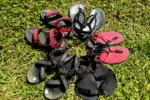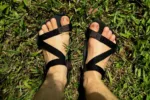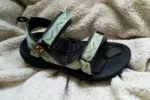Finding the perfect fit for your hiking sandals (5 steps)
This post may contain affiliate links. This means that we may receive a small commission from purchases through those links. Read more in our affiliate disclosure.
So, there I was, halfway up the mountain, realizing my very first hiking sandals were two sizes too big. Don’t laugh! It can happen to the best of us. That’s why we need to talk about how to properly fit hiking sandals—so your only hiking drama is whether to have s’mores or not at the campfire.
Properly fitting your hiking sandals is vital for comfort and injury prevention. Always consult brand-specific sizing charts and, when in doubt, size up. Hiking sandals should snugly fit your foot, offering enough space—about a thumb’s width in front of the toes, and nicely aligned at the heel. The fit varies among closed-toe, over-the-foot, and between-the-toe styles, the latter two being more adjustable. Sandals should feel snug but not tight around the ankle, but the toe strap can be looser if you like. Simple sandals can often be customized for a better fit. Different designs cater to different foot shapes, like flat, wide, or narrow feet, and varying degrees of arch support. Women’s and men’s models differ, and sometimes crossing gender lines provides a better fit.
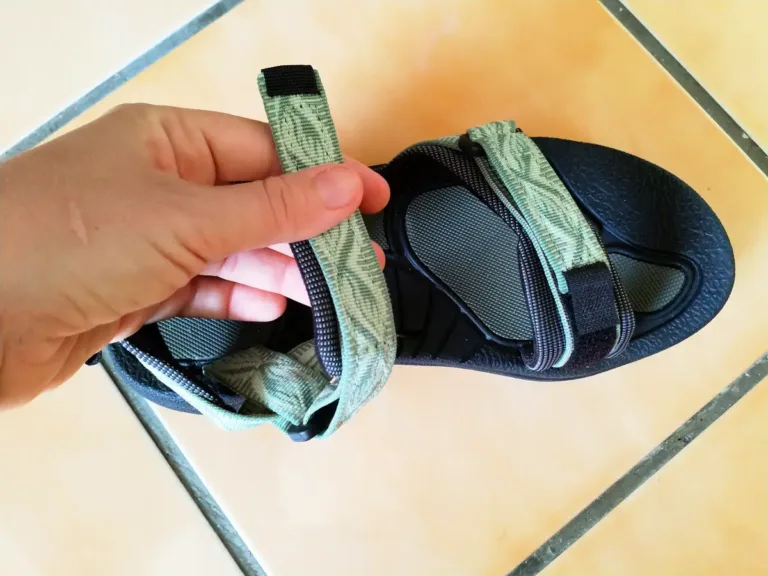
Finding the right fit for your hiking sandals is more than just a matter of comfort. It’s the key to preventing blisters, avoiding foot fatigue, and really, truly enjoying your hikes. Here are the steps to make sure your hiking sandals fit better than a glove:
Table of Contents
- Introduction
- 1. Finding the right size
- 2. How do I make sure my sandals fit right?
- 3. Fit & Adjustments for different kinds of hiking sandals
- Adjusting closed-toe hiking sandals
- Adjusting over-the-foot strap hiking sandals
- Adjusting between-the-toe strap (thong) sandals
- 4. Can I customize my hiking sandals for a better fit?
- 5. Sandals for different foot shapes and conditions
1. Finding the right size
In an ideal world, you could march into the outdoor store next door and try your next sandals on—but sadly, many of the best and most comfortable brands aren’t commonly available in physical stores. So, you’ve got to figure out which size to order online.
First things first, I can’t stress this enough: always, always check the sizing chart. That’s the roadmap to your perfect fit. Every brand will have their unique interpretation of what they call “size 9,” or “size 6,” and it’s not universal—trust me, I’ve learnt it the hard way.
Some brands even go the extra mile to help out—they provide print-outs with outlines of sandals for every size—just align your foot with the markings for the straps on the printout, and you will see if you got the right size.
In my experience, these work really well. They are especially helpful if, for example, you want to make sure your wide feet will fit comfortably. That’s why, even if you’re ordering from Amazon or the like, it’s always worthwhile to check the manufacturer’s homepage for such sizing helps.
Should you size up or down in hiking sandals?
Even with sizing charts and print-outs, it can still be a bit of a gamble. If you’re stuck between sizes, or just plain unsure, my golden rule is: size up. You might think that a bigger size will have your foot sliding around like a bar of soap in the bathtub. But here’s the thing—hiking sandals are adjustable.
Unlike regular shoes where the fit is mostly determined by the shoe’s size, hiking sandals usually come with adjustable straps. So even if the sandals are slightly larger, you can cinch the straps for a more secure fit. As an additional feat, this gives you the space to loosen the straps if your feet swell after a long day of hiking, or if you want to wear thick, fluffy socks. And if you find the sole is too long—if it’s made from solid rubber, you can even alter that!
How do you know if sandals are too big or too small?
A properly fitting hiking sandal will encase your foot without cramping it. This means you’ve got to make sure enough space is left around your foot: Your heel should align with the back of the sandal without hanging off, and there should be a bit of room in front of your toes—a space about the width of your thumb is a good measure for your standard well-padded sandal.
This prevents your toes from hanging off the sole even as you roll your foot—they should be able to apply force through the sandal to the ground without feeling precarious or unsupported. Plus, nobody wants a stubbed toe. Having some more space is less problematic, but at some point it can get annoying, as the front of the sandal can start scraping the ground as you move your foot forward.
For more minimalist sandals with thinner soles, you need less space in front of your toes, since those soles lose less length when rolling your foot—for a sole thickness of 1cm or less, aim for half a thumb width of space; and for soles thinner than 5mm, I find that no extra space is necessary at all.
Quite the opposite, actually—those really thin, flexible soles tend to sag at the toe end under their own weight, and extra space exacerbates this issue and leads to your sandal scraping the floor. So, as little extra space as possible is the way to go in this case!
2. How do I make sure my sandals fit right?
Now that we’ve got sizing out of the way, let’s dig into the art of the perfect fit. The beautiful part is that sandals are way more adjustable than boots, often with multiple straps that you can tighten or loosen as you wish.
Should hiking sandals be tight or loose?
One of the first things people struggle with when fitting hiking sandals is deciding how tight they should be. Imagine this—you’re lacing up your sandals and you pull the straps as tight as they go. Seems secure, right? Wrong! Tight is not always right. Too tight, and you’re on a one-way street to Blisterville. On the other hand, a loose fit can lead to slipping and sliding—almost as if you’re hiking on a pair of skis. The key is to find a happy medium.
Think ‘secure’ rather than ‘tight.’ Your foot should feel snug and well-seated in the sandal, with no sideways movement—but there should be no pressure. Different parts of your sandals can be adjusted to different degrees of tightness. For example, I like to keep the straps over my toes a bit looser, while the heel and ankle straps are a bit tighter for support. This depends on the type of sandal—closed-toe vs “normal” vs thong sandals—we’ll cover the specifics below.
Do hiking sandals loosen over time?
Sandals tend to become softer over time and the footbed will mold to your foot, becoming more comfortable as it contours to your unique foot shape.
But what about the straps? Since hiking sandal straps are typically made from synthetic materials, they might soften a bit with use, but they won’t significantly lengthen or stretch out, even after repeated wear. So if you’ve got the fit right initially, you won’t have to worry about your sandals becoming too loose. And if they do start to feel a bit off, you can always adjust the straps again.
Some straps lengthen a bit when they get soaked, though. You’ll quickly learn when to tighten them a bit so they feel snug again.
3. Fit & Adjustments for different kinds of hiking sandals
As we’ve discussed in our article about how to choose the perfect hiking sandals, there are rather different types—each with different levels of adjustability.
For some sandals, the manifacturer offers specialized adjustment instructions: See here for Xero, Chacos, Bedrock, Shamma.
Let’s go over the various hiking sandal styles and how to get them fitting like a glove.
Adjusting closed-toe hiking sandals
First up, we’ve got the closed-toe hiking sandals. These beasts offer a fantastic combo of protection and ventilation. Their adjustability is similar to boots—with laces snaking their way up the front. That’s why the size needs to match your foot pretty well for these kinds of sandals.
The fit should be snug enough to keep your foot secure, but loose enough to allow for some wiggle room for your toes, with about a thumb’s width of space in front. Your foot will swell as the day goes on, so give yourself a little space. The heel should be firm in the cup, and not sliding up or down as you walk.
Adjusting over-the-foot strap hiking sandals
Next in line, we’ve got the over-the-foot strap hiking sandals. Now, these are the chameleons of the sandal world—extremely adjustable. As long as the sole is the right size for your foot, you can play around with the straps until you hit the comfort jackpot.
Start by loosening all the straps, slide your foot in, and then adjust each strap individually. The forefoot strap should be secure, but not overly tight—you don’t want to squash those toes. The instep strap should be snug—this is the one that holds your foot in place. Finally, the heel strap should be tight enough to prevent your foot from lifting off the sandal, but not so tight that it’s digging into your ankle.
Adjusting between-the-toe strap (thong) sandals
Last, but certainly not least, we’ve got the between-the-toe strap sandals. Don’t be fooled by their simple design—they offer great comfort if adjusted correctly. The heel strap is easiest—make sure your foot is aligned with the back of the sole. Then, you’ve got to play around with the “Y” shaped straps in front until you find something that works for you and your walking style.
You can adjust the tightness of these straps, as well as their relative length. I like to have the middle of the “Y” sit right behind the gap between the big and small toes for the most comfort, but you can also experiment with moving this point more towards the outside of your feet. I think this depends a lot on your personal walking style.
The strap that goes between your toes should be on the loose side, much looser than you might initially think—allowing a tiny bit of air between the sole and your forefoot as you walk. That way, the sandal can re-align itself at every step, and doesn’t start cutting in.
I admit, adjusting thong sandals is much more of a science than with the other types. If you find your sandals constantly slipping into uncomfortable positions, you might need to adjust the straps—or it could be a sign that something is “off” about your walking form.
Thong sandals train you to walk with good form—ever since I adjusted my gait to stop them from slipping around, my knee issues have gotten much better.
4. Can I customize my hiking sandals for a better fit?
Yes, my adventurous friend, you can! I recommend buying a size with a well-fitting sole—and if you have to customize the straps by shortening them, go for it.
The simpler the sandal, the easier it is to modify the sole, too. Minimalist and thong sandals often allow cutting the sole to match your foot shape. I’d only recommend this approach in special cases—but if you find a sandal with perfectly fitting straps but a way overhanging sole, why not? My friend Samantha did this to her Xero Amuri Z-Treks:
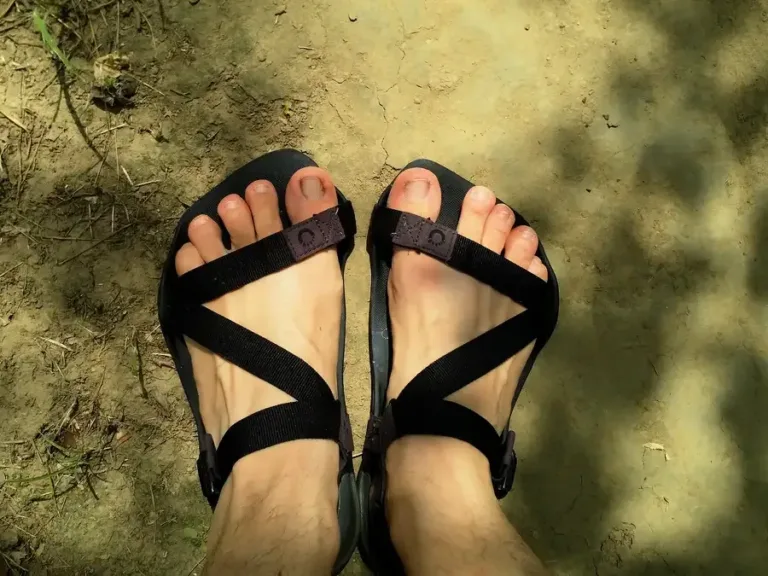
(You might notice she didn’t leave the thumb’s width of space I talked about—you’re right. She had walked in these for a while already, so that her toes left an impression on the sole—and indicated exactly where to cut without having them hang over.)
With more robust, well-cushioned sandals, it’s best to find a pair that fits you well from the get-go.
5. Sandals for different foot shapes and conditions
Now let’s talk about finding the right sandals for different foot shapes and conditions. It’s not a one-size-fits-all world, folks.
Best hiking sandals for flat feet with lots of arch support
Got flat feet? No problem. There are sandals designed with extra arch support to help distribute your weight evenly across your feet, preventing fatigue and pain. Our recommendation are the Chaco Z/Cloud: This model features a podiatrist-certified LUVSEAT™ PU footbed for extra arch support.
Another great option are the Teva Terra Fi 5 Universal, which have a contoured footbed and great arch support to offer extra comfort for flat feet.
Best hiking sandals for wide feet
And for the wide-footed among us, fear not. There are hiking sandals out there with wider footbeds and adjustable straps to accommodate your needs. One great option are the KEEN Newport H2: These sandals are widely known for their wide fit and toe protection.
If you prefer over-the-foot strap sandals, my recommendation are Source Gobi hiking sandals, which have kept my own wide feet comfortable for years.
And if you want to go even airier, note that thong sandals don’t restrict your feet from the side at all, perfect for wide feet! My favourite thong hiking sandals for wide feet are the Shamma Warriors Maximus.
Best hiking sandals for narrow feet
Not to forget the narrow-footed hikers! The Merrell All Out Blaze Sieve are a crowd favourite: These sandals have an adjustable strap system and a narrower fit that works great for slim feet.
How does the fit differ between Woman’s and Men’s hiking sandals?
Women’s feet tend to be wider around the toes and narrower at the heels, while men’s feet have a more constant width along the foot—and that is reflected in their respective hiking sandals. Sometimes women’s models are lighter, too.
If your feet don’t conform with these generalizations, you might find that the other gender’s sandals are more comfortable for you—don’t be afraid to experiment. But beware of the wildly different sizing charts—men’s sizes are generally much larger than women’s!

